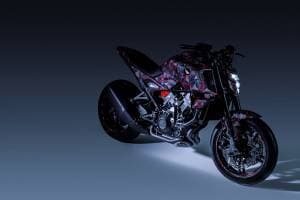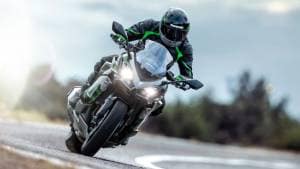2020 Kawasaki Ninja 1000 SX vs Versys 1000 - Which is the sport tourer to buy?
The photos you see here are from the beautiful Malshej ghats near Mumbai. If you agree that Maharashtra completely transforms into green heaven during the monsoons, then places like Malshej are like the upper tier of that heaven. During that season, this place looks magical as the clouds descend on the peaks of the Kalsubai mountain all through the day, there is a mist that flows through the vegetation around and many flowing rivulets along the route add a sense of calm. A clam that is best enjoyed when you actually break it, break it with the sound of a big engine howling through the mountain road. This time we had the right bikes for this green heaven too - a glitzy green Ninja 1000 and a sophisticated white Versys 1000.

The last time I rode a Kawasaki on these roads it was my own 2011 Ninja 650, which I used to call Fiona. I called her that because the size, colour, grunt and those giant mirrors mounted on the fairing always reminded me of Fiona, the lady-ogre from Shrek, and her peculiar ears. Somehow the Ninja 1000 reminded me of her too, maybe for the exact same reasons. But compared to the 650, the 1000 sounds so much better, handles so much sharper and those ogre-eared mirrors on this one also feel like the crosshairs when gunning through the winding switchbacks. Surprisingly, the large, heavy and tall Versys 1000 doesn't fall too far behind when attacking these roads either. I would certainly call it Shrek if I had one (and only if it was green).
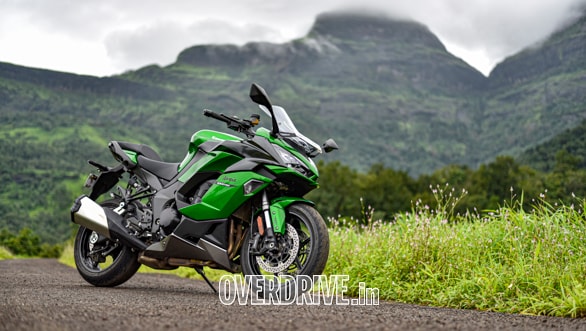 The Ninja 1000 SX is the newest sport tourer from Kawasaki and replaces the successful Ninja 1000 at a similar price point but with new features and tech
The Ninja 1000 SX is the newest sport tourer from Kawasaki and replaces the successful Ninja 1000 at a similar price point but with new features and tech
 The Versys 1000 is the most economical ticket into the litre-class four-cylinder adventure sport genre
The Versys 1000 is the most economical ticket into the litre-class four-cylinder adventure sport genre
In fact, the Versys and the Ninja 1000 are tied together by the common thread of their engine and if you were to walk into a Kawasaki dealership to get yourself a touring machine for exploring roads like these, both could appeal you in their own unique ways. What would make the buying decision tougher is the marginal price difference between the two. In fact, that is the idea behind this story - figuring out which is the better buy.
Design
The designs are the first big distinguishing factor between the two motorcycles. The Ninja casts the silhouette of a forward-biased, sporty machine, while the Versys stands tall and wide like an adventure motorcycle. It is so big in fact that it even makes a set of sportbike-sized 120/180-section tyres look skinny. That gives it a very unique stance - one that might repel riders who are wary of top-heavy motorcycles or attract those who enjoy a large size on their touring machines.

Over its three generations, the Versys has shed its bulbous design for a shaper styling and the current one is the sharpest looking adv out there even without wearing a beak. That is thanks to its sportsbike inspired nose section, the massive bits of fairings and shrouds behind it, and the rounded off tank with the pronounced knee recesses.
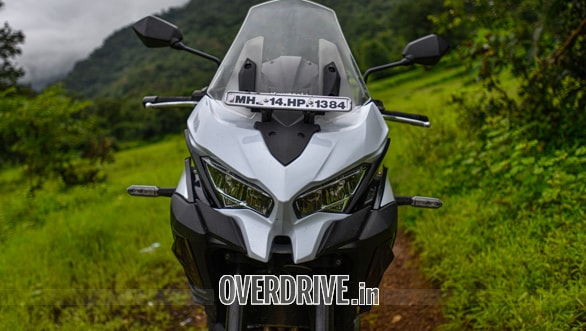 The Versys 1000 is easily the sharpest looking adventure tourer around even without wearing a beak
The Versys 1000 is easily the sharpest looking adventure tourer around even without wearing a beak
But speaking of sportbike inspiration, the Ninja 1000 certainly looks the part with its sculpted fairing, the step-seats, clip-on bars, an exposed perimeter frame and a sharp tail section. If you are transitioning from a supersport body style to something a bit more practical for sport touring, the Ninja 1000 would be a good bet. What you see here is the Ninja 1000 SX, which is slightly different to look at compared to the Ninja 1000 it replaces. Gone are the exhaust canisters on either side and in comes a more conventional, single-sided can. It's interesting to see Kawasaki take this route, knowing that the system would incorporate all additional emissions-curbing hardware required for the Euro V/BSVI norms - and the older setup would certainly allow more leeway. In taking this design direction, the SX seems to have lost a bit of its imposing stance, but on the other hand, it now looks more like a practical supersport, than a faired-Z1000 and that's a very good thing for its target audience.
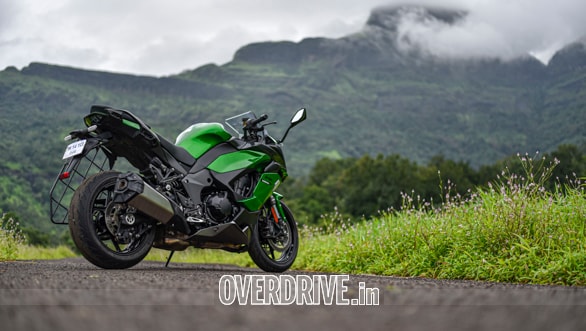 The Ninja 1000 SX has some visual diffrentiators over the outgoing Ninja 1000, which looked more like a faired Z 1000
The Ninja 1000 SX has some visual diffrentiators over the outgoing Ninja 1000, which looked more like a faired Z 1000
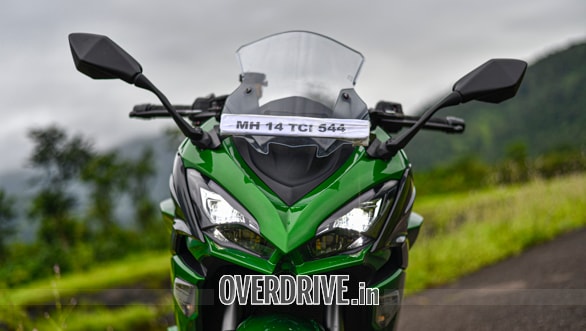 The sharp front end with the LED lighting looks great, but has very little distinction over the Ninja 650/400 in a passing glance
The sharp front end with the LED lighting looks great, but has very little distinction over the Ninja 650/400 in a passing glance
Chassis and peripherals
While the perimeter frame is more or less similar on both motorcycles, there are obvious changes to the steering geometry for their respective riding styles. But the downside to this sharing, however, is that the steering yolk sits pretty low on the Versys and to compensate for it, it uses very tall handlebar mounts (see picture) - taller than most aftermarket handlebar risers that you will see on most Advs.
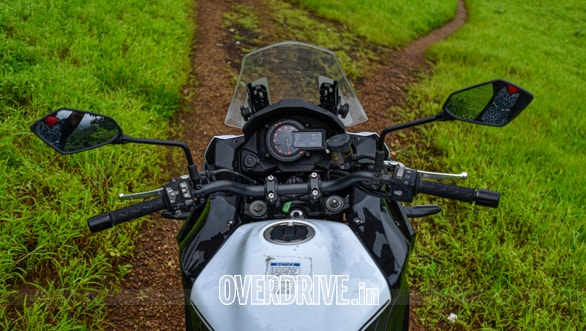
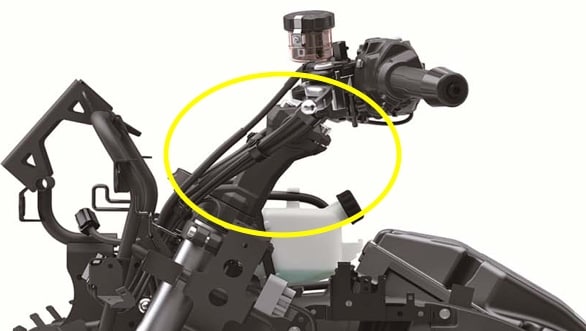 The Versys has very tall handlebar mounts becasue of a low-set steering yolk, thanks to the chassis sharing with the Ninja 1000
The Versys has very tall handlebar mounts becasue of a low-set steering yolk, thanks to the chassis sharing with the Ninja 1000
But despite that, the handlebar is still a tad bit low for standing up and riding, and the sportbike inspired tank makes it difficult to grip onto when standing. Furthermore, riders with adventure boots greater than size 11 could also find their right toe hitting the clutch casing often. The sum of this always gives you the feeling that the bike is going to throw you over the 'bars when you stand up for the harsher stuff on the road.
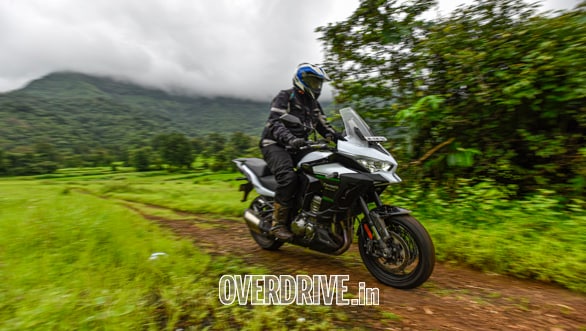
The chassis of the Ninja 1000 feels more purpose built in comparison. Compared to the older 1000, the SX runs a steeper steering angle and a 4mm shorter rake, which translates to improved handling characteristics with sharper and quicker turn-in. The rider, seat and peg geometry is quite relaxed than what's its sporty demeanour would suggest and that explains its popularity as a sport-tourer.
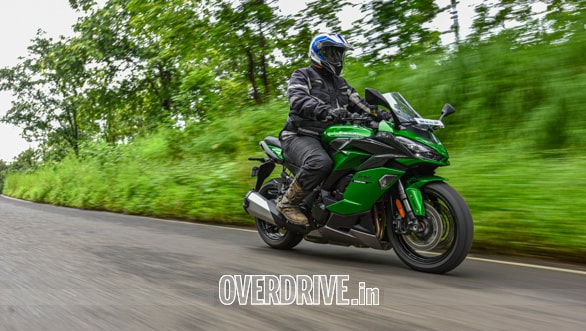
The Ninja also has a lower seat height than the Versys, making it friendlier for shorter riders. The seats are fairly comfortable for day-long riding too, but the Versys clearly outclasses the Ninja in this department with wider and comfier seats, and it's upright seating posture. U-turns are a tad bit difficult on both motorcycles though, because of the early steering lock on the Ninja, and the tall height and top-heavy nature of the Versys.
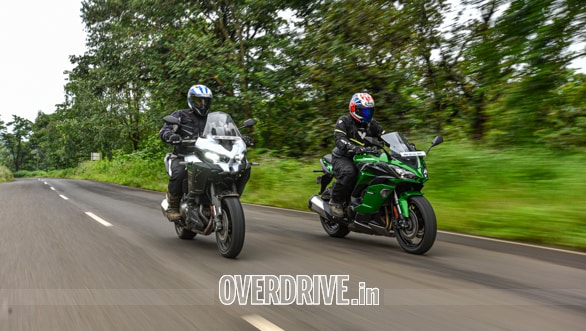
The subframes of both motorcycles are very different too and while the Versys can take side panniers and a top box, on the Ninja you can have either the panniers or the top box, not both.
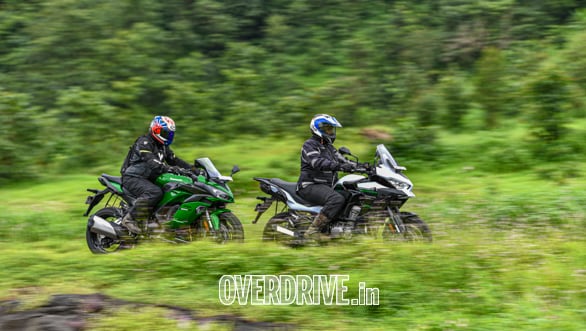
The Versys extends its lead in the tourer-friendliness department with dedicated spots in the fairing for cornering and auxiliary lights, a larger alternator (Kawasaki couldn't confirm the figures) for ancillary electricals, an inbuilt horizontal frame to protect the engine and a larger taillight for better visibility to other motorists at highway speeds. Speaking of lights, the LED headlights on both motorcycles are quite average and their illumination doesn't match the speeds you would be doing while sport touring, and therefore auxiliary lighting is a must.
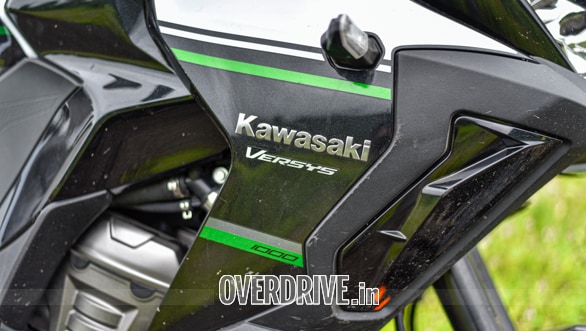
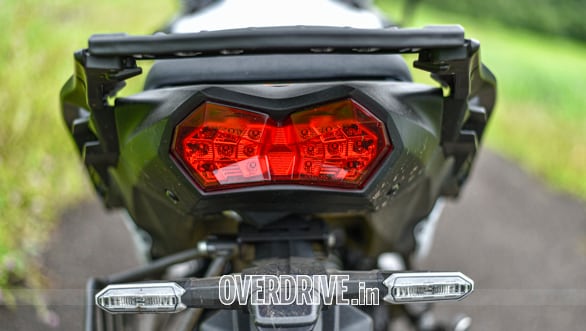

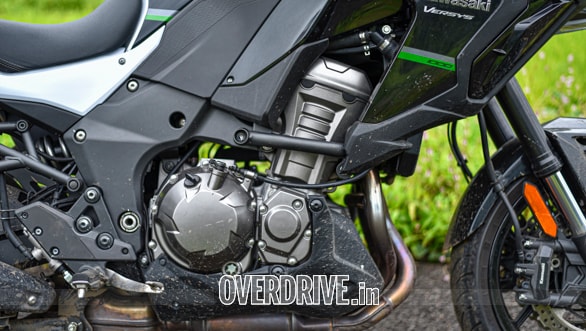
Riding dynamics
Both the motorcycles have mono-shocks at the rear with remote preload settings that can be conveniently adjusted by hand for pillion and luggage requirement, without the need of tools. The forks on both motorcycles allow fine-tuning the compression and rebound. The Versys rides on fatter forks than the Ninja's and given its more adventurous intent, it has longer suspension travel too (F/R - 150/152mm versus Ninja's F/R - 120/144mm). Despite that difference, the Versys is only marginally better than the Ninja at tackling bad roads. It's only the deeper potholes where the higher ground clearance and travel of the Versys has a bit of an advantage, but otherwise, neither of the bikes can trample across bad terrain the way a Tiger or an Africa Twin would. These are road bikes, after all, and they shine when shown the blacktop.
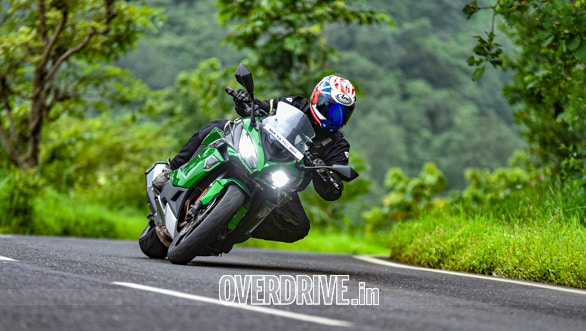
The Ninja 1000 was known to be lazy through corners, but the revised steering geometry on the bike has made a world of a difference to its cornering capabilities. The motorcycle comes with Bridgestone Battalax Hypersport S22 tyres which were primarily designed for hyper-bikes putting out close to 200PS, and on a motorcycle like this one, they do an exceptionally good job of arcing a clean line through a corner even with a pillion on board. The way the seating geometry is laid out, the rider doesn't feel burdened while riding two-up either. The only downside to the Ninja's riding posture is that at higher lean angles the handlebars feel a bit too close to the tank and don't allow as much room as you would expect of a sporty machine like this. But the flip side to that is a very comfortable riding posture for the open highways and when the need be, you can also sit fairly upright to give the back some rest.
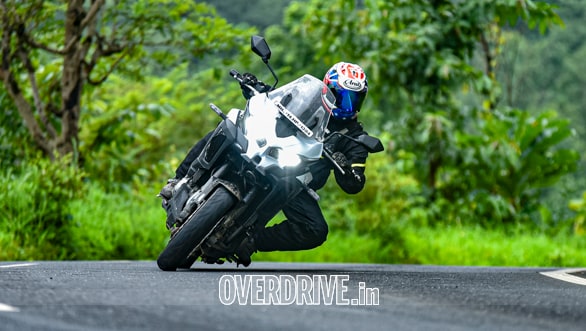
But if you don't find the Ninja roomy enough, then it's the Versys that should work for you. Its got tonnes of space and while it is not the cushiest adventure tourer around, it's relatively firm setup makes it less wallowy through the curves and has excellent stability under braking even with a pillion. The Versys is shod with Bridgestone Battlax T31 sport-touring tyres, which aren't as super sticky as the Ninja's but have a noticeably better wet-weather performance. The radially mounted brakes on both motorcycles feel very confident even while braking under load.
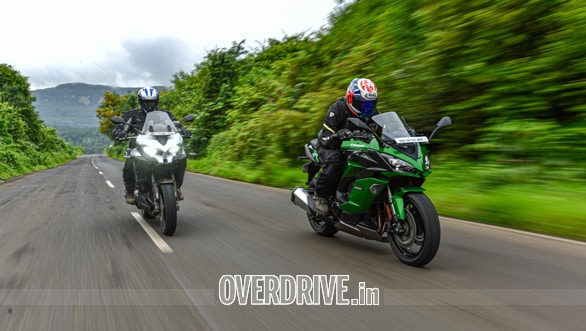
Powertrain and electronics
Of course, the electronics have a big role to play in how stable the two motorcycles feel. Both come with an IMU which enables tricks and safety systems like cornering ABS and multi-level traction control. But in this department, the Ninja outshines the standard Versys sold to us by incorporating a bi-directional quick-shifter. The light, assisted clutch is easy to work with but a quick shifter makes the ride a bit more fun. It's a little bit clunky if you downshift without the clutch at lower revs, otherwise, in the higher range, it works just as smoothly and efficiently as the track bikes from Kawasaki. The Ninja also gets rider modes like Rain, Road and Sport which not only alter throttle maps but also reduce electronic intervention as you go up the order. The Ninja's traction control also feels more fine-tuned and discreet compared to the Versys, which cuts throttle far too often (and quite violently at that, like the older ZX10R) over potholes and speed breakers, no matter how measured you are with the throttle. That makes it feel a bit more primitive, though its specs suggest otherwise.
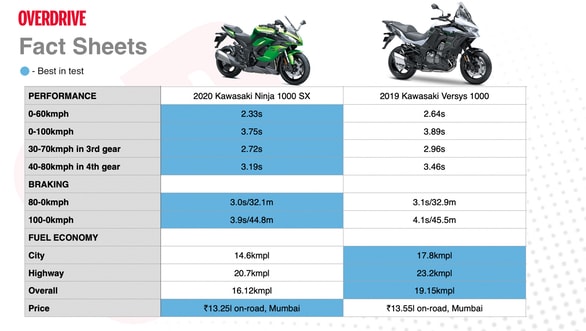
The Ninja adds a further layer of goodness for nerds by incorporating a TFT screen that has cool read-outs for the intensity of throttle and brake inputs, lateral Gs on the rider's seat during acceleration and braking, and a lean-angle readout that stores the best "scores". Of course, you wouldn't ideally glance at any of those while riding, but this is the stuff of teenage joys and meant for those brag games on group rides. The screen also pairs with Kawasaki's Rideology app on the phone and allows you to set the riding mode parameters or logging your rides.

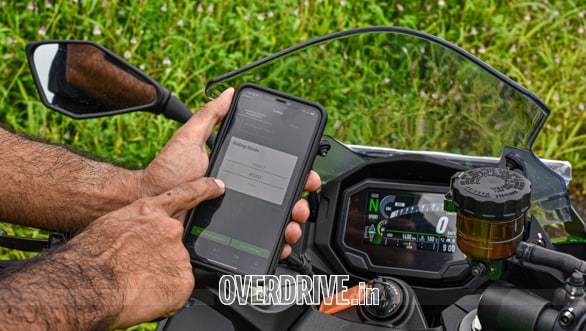
The Versys only gets these advanced electronics on the SE model, which isn't available in India yet. Also common to both bikes is a cruise control system that works with the IMU and is enabled using ergonomic controls on the handlebar. I also like how easy it is to disengage it - the conventional dab of the brake or change of the gear, or you can simply shut the throttle an extra degree, which is much smoother!
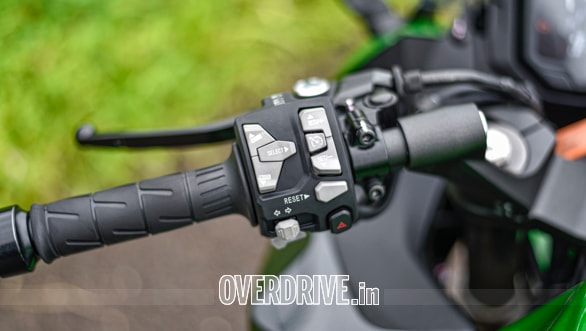
Speaking of smooth, let's talk about the engine. Both motorcycles get their motivation from the same four-cylinder 1,043cc engine and it is typical Kawasaki - a little buzzy at the top but largely smooth and creamy through the rev range. In the Ninja, it puts out more power and torque too and you won't have to ride at the limit to understand the difference. The Ninja feels a lot more eager in its throttle response. The engine puts out 120PS in the Versys and around 142PS in the Ninja, which isn't exactly litre-class output in 2020 - but the Ninja's 21st-century electronics make sure that all that power can be harnessed in a fun way. Both bikes hit the ton from standstill around the 4s mark, with the Ninja being the quicker one as expected. Once you have experienced the smooth power delivery and the crackling performance of these motorcycles, it's hard to like a twin or triple-cylinder motorcycle for sport-touring use.
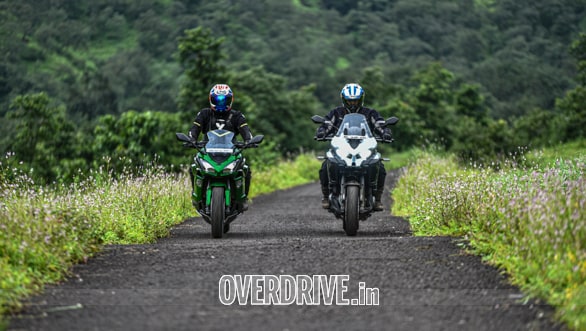
The powertrain does come with the typical four-cylinder tantrums of getting hot for city use. The Ninja is more discomforting on that front since all the heat rises up from the handlebars and into your helmet, while the Versys dissipates it around your feet. But on the highway, the venting works well and keeps all the heat away from the passengers. On a related note, the Ninja also flows a lot more air into the helmet but taller riders might need to upgrade to a double-bubble screen to avoid buffeting at highway speeds. The Versys, on the other hand, has better weather protection with its adjustable screen and it works well with both helmet types - cross-tourers as well as sport, while the Ninja prefers the latter.
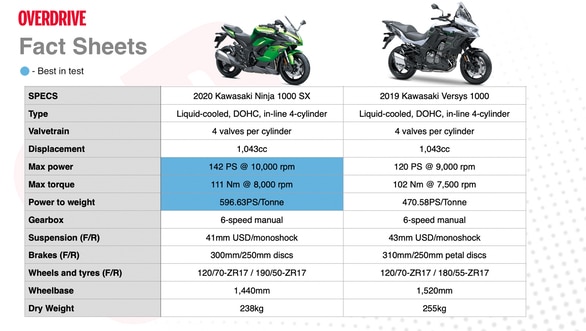
Verdict
If exploring new lands, riding on B-roads and going off the beaten path often are your ideas of motorcycle touring, purpose-built adventure bikes will complement that intent far better than these two. If you would rather go touring on developed highway corridors like Delhi-Rajasthan, Mumbai-Gujarat or Bengaluru-Chennai to name a few, or if you are very sure about the quality of the roads you will be touring on, or you simply fancy the idea of commuting on a litre-class motorcycle - either of these could make a lot of sense for you. For litre-class sports tourers, both the machines are priced very attractively (the only catch being Kawasaki's relatively pricier service and spares), compared to the likes of the Ducati Multistrada or the BMW S 1000 XR.

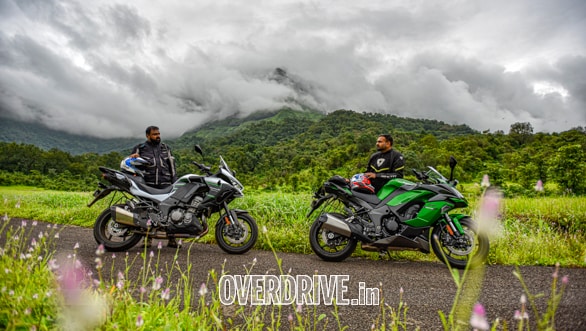
The Versys is certainly the easier one to live without of the two because of its relaxed ergonomics and better touring ethos. But if you are alright with a slightly more committed riding position and if a set of panniers and a 12V charger are all the touring accessories you need, it's the Ninja 1000 SX that you want to sign up for. Despite being the cheaper of the two, it packs in a lot more tech. More importantly, though, it is a lot more engaging to ride and that ensures that it will make you smile for longer throughout all those miles - and that makes it the winning package for me.
Photography Anis Shaikh
Starts Rs 10,79,000
1043cc
6-Speed
142.00
111.00
-NA-
